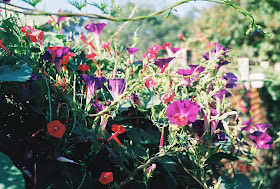It was one year ago, on December 31, 2009, that I launched this blog. My wife had been encouraging me to do it. “You could put some of your writings out there, and you could talk about some of the things you comment on every day when we watch the news,” she said. So I decided to give it a try. Not Dark Yet seemed the perfect title, inspired by the song by Bob Dylan. I began my blog as a place to share essays, poetry, commentary about current events and other things that mattered to me. I stated in that first blog entry, “My interests include poetry, religion, politics, nature, conservation, and striving toward the common good. This blog will cover observations of life and shared events.” 136 posts later, I am now looking over a year's worth of blogging.
The entries that I most enjoyed writing include my recollections of my father (September), and my “Explorations of Mystery and Wonder” (May). I weighed in on the healthcare debate early in the year. The darkest observation points for me involved certain Supreme Court decisions. I included some poetry, thoughts on spirituality, childhood experiences, and a tribute to my beloved Mr. Higgins (February). I’ve also tried to let Bob Dylan make some “cameo” appearances from time to time (he appears 11 times in the blog labels – “poetry’ is the only label with more occurrences).
Back in June, Blogger began making statistics available so I could see how many people were viewing the blog. Since they started keeping track in June, there have been some 4,600 pageviews from at least 24 countries. I’m even able to track the most popular postings. Here are the Top ten entries according to the number of pageviews:
1. Southern Nights and Stereotypes – A look at Rick Bragg’s All Over but the Shoutin’.
This one is far out ahead of the others, with over 650 page views.
2. Wendell Berry and the Sacred Task of Writing – One that I sat down and wrote on the spur of the moment after being inspired by a radio discussion of one of Mr. Berry’s books.
3. Tibetan Sand Mandala: Precision and Prayer – My “photo journalistic” attempt to document the monks’ visit to Birmingham.
4. Icons: What’s in a Name? – This was the quirkiest piece that I posted. I was always bothered that I couldn’t get those 21st century icons lined up symmetrically. Then when I saw how many people were viewing it, I went back to rework it, swapping out a picture that I could make line up properly.
5. An Ordinary Life – I am very glad that this piece about my friend, Meg Parker, made the top 10 list. It looks back on a foundational period in my life.
6. Finding Christmas – an important essay for me, I’m glad some other people liked it.
7. When Faiths Collide – a review of Martin Marty’s book. I thought the book had something important to say about interfaith dialogue.
8. Don’t Take my Word for It – One of my tributes to His Holiness the Dalai Lama.
9. My Back Pages – A fun video from a celebration of Bob Dylan’s music. Although I didn’t mention it at the time, my birthday was the occasion for posting that one (“I was so much older then, I’m younger than that now”).
10. Songs for Christmas: Christmas Time is Here – It warmed my heart that Charlie Brown made the top 10 list!
And honorable mention goes to:
11. Every Grain of Sand – this one was holding in the top 10 until it was edged out by Charlie Brown’s Christmas. I keep it in the list just because it stands as a great work by Bob Dylan.
Blogger’s tabulation of countries represented by viewers includes The United States, Russia, Canada, Spain, The Netherlands, Germany, Brazil, France, Denmark, The United Kingdom, Croatia, Slovenia, Indonesia, Taiwan, Australia, Vietnam, Hong Kong, Belgium, India, Saudi Arabia, The Philippines, Italy, Albania, and Israel.
I’ve had fun with the blogging this year. Many thanks to all who have followed this blog, and a special thanks to those who have shared their comments along the way. I look forward to another year. Who knows what topics will arise in the months ahead?
*






































